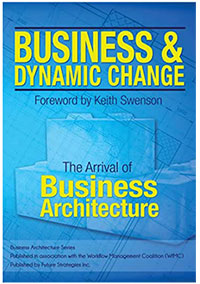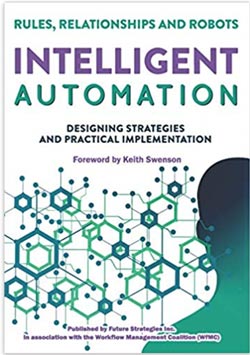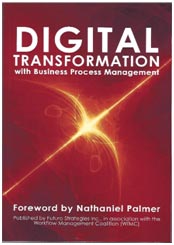KCI Publications
Business and Dynamic Change
The Arrival of Business ArchitectureToday with impending 4th Industrial Revolution emerging and the rapid increase in technology advances related to IoT, AI, Nano Technology, Biotech, Big Data Analytics and several others there is a need to have a systematic approach to dealing with the structure of organizations. Analysts especially business analysts, must deal with transforming how the organization supports customer interactions. What do these changes mean for business performance, adaptation and continuity?
Managers must deal with situations like estimates of 30 billion or more connected devices, that imply far too many devices, interactions, customer groupings, changes in consumer interest and government regulations for slow reaction time. What is the impact of these changes on the organization? Does remote work help or hinder performance? The way to make sense of the flow of work and rapidly adapt to the changes is to apply some form of business architecture techniques to each situation as it arises and review alternative business structures. That accomplished, the new structure is input to the enterprise architecture to define systems needs for execution.
Launched jointly by the Workflow Management Coalition (WfMC), Knowledge Consultants, Inc. and published by Future Strategies, Inc., “Business and Dynamic Change” addresses a current perspective on dealing with these changes. It is looking at what the impact of the different architectural approaches is having on business execution not in some distant scenario but today!
The book presents a series of articles by known experts regarding critical issues currently facing adopters and practitioners of business change.
This book is available on Amazon. Amazon
Intelligent Automation
Knowledge Consultants president Frank Kowalkowski has a chapter in the recently released book titled ‘Intelligent Automation’. The chapter is titled ‘Intelligent Automation and Intelligent Analytics’ and focuses on how to include analytics with the automation effort. The book contains 7 chapters on automation and a number of case studies to see how organizations implemented intelligent automation. Here is a brief excerpt from the start of the chapter…
The level of activity around the topic of intelligent automation (IA) indicates a high level of interest by management in improving the performance of their organizations. Like all waves of ideas and technologies, this one has a history as well as a mix of value and hype. Intelligent automation and intelligent analytics are in the middle of a wave and are a maturing discipline.To order the book or see the contents go to Amazon
There is plenty of material in this book about IA so the focus of this chapter is on the analytics and how you position them to take advantage of the smarts in the automation. Automation, especially automation of operational processes has become ubiquitous in most organizations. Intelligent automation involves applying analytics, and especially ‘smart’ analytics, to processes, mostly operational processes. The goal is more efficient and effective control of the process.
There are, at least, four aspects to intelligent automation in an organization…
Or, you can order direct from the publisher.
Real World, Theory and Application
 Frank Kowalkowski of KCI provided a features chapter in this book titled ‘Using Analytics to Identify Process Opportunities’. In the opening paragraph under the heading of ‘Process Performance and the Business Enterprise’ he focuses on process performance management and improvement. Here is the opening paragraph.
Frank Kowalkowski of KCI provided a features chapter in this book titled ‘Using Analytics to Identify Process Opportunities’. In the opening paragraph under the heading of ‘Process Performance and the Business Enterprise’ he focuses on process performance management and improvement. Here is the opening paragraph.
Since processes are critical to business execution, process performance management and improvement have become two key aspects of BPM for improving business performance. These two key process approaches form the basis of enterprise transformation, integration and consolidation within the enterprise. They also support integration across enterprises and form the foundation for e-commerce, e-government and enterprise excellence. Organizations are good at assessing due diligence regarding financial, market and legal issues. However, studies (Michael Porter and others) show that most structural changes requiring integration fail due to operational (read process) and/or cultural incompatibilities. Both of these issues can be addressed with some core process and cultural analytics.
The book sponsored by the Workflow Management Coalition (WfMC) is in their BPM series. Copies of the book are available via Amazon or directly from Future Strategies, Inc.
To order click on one of these links
BPM Transformation and Real- World Execution
 Frank Kowalkowski of KCI provided a features chapter in this book titled ‘Improve, Automate, Digitize. In the opening paragraph under the heading of ‘A Sensible Method of Change’ he focuses on an orderly method of change.
Frank Kowalkowski of KCI provided a features chapter in this book titled ‘Improve, Automate, Digitize. In the opening paragraph under the heading of ‘A Sensible Method of Change’ he focuses on an orderly method of change.
Here is the first Paragraph.
Have you ever wondered why organizations spend a lot of money, get involved with large projects for improvement or transformation, get outside help, and yet, still don’t realize the value they expected? Then, several years later, things seem to get on track or they get worse. Did the management learn anything? Every time a new technology, method or other ‘hot thing’ comes out, organizations try to take advantage of it before the competition. Think knowledge management in the 1990s, AI in the 1980s, Y2K, ERP packages and so on. Now we have digitization, process automation and myriad other technologies pushing their way into the business space.
The book sponsored by the Workflow Management Coalition (WfMC) is in their BPM series. Copies of the book are available via Amazon or directly from Future Strategies, Inc.

